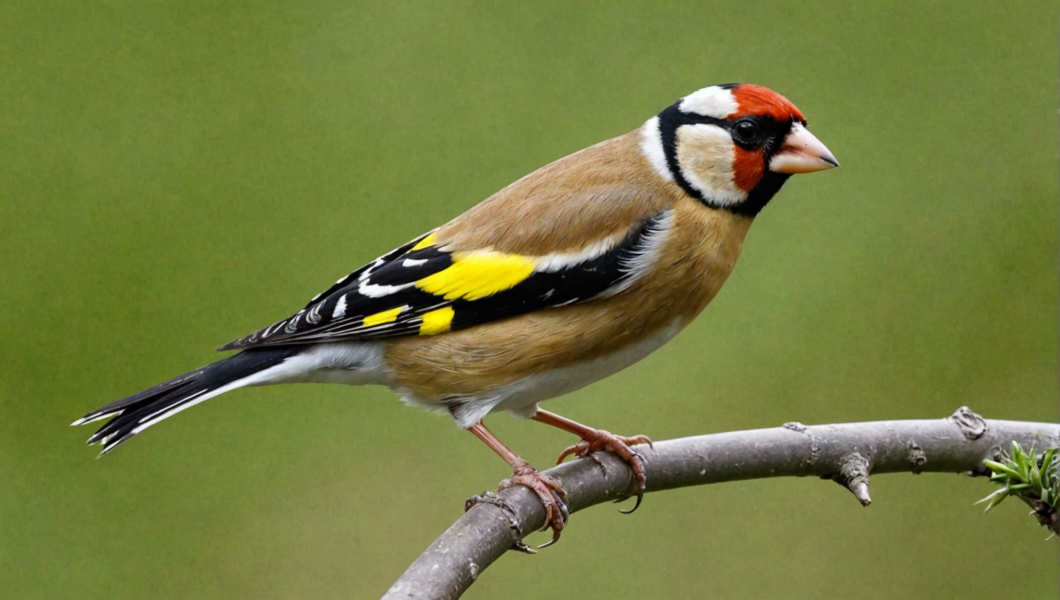About the Goldfinch Bird
The goldfinch bird, scientifically known as Carduelis carduelis, is a common passerine bird belonging to the finch family. It is renowned for its vibrant plumage, making it one of the most colorful birds found in gardens. With its melodic song, it is easily recognizable and captivating. Let’s dive into the details of this beautiful bird with its distinctive red mask.
Physical Characteristics
The goldfinch bird is a small to medium-sized passerine, measuring about 14 cm in length and having a wingspan of 21 cm to 25 cm. It weighs between 13 g and 19 g, making it slightly smaller than the common house sparrow. The most striking feature of the goldfinch is its colorful plumage. Its head is black and white, with a wide red patch forming a characteristic facial mask around its eyes and cheeks. The body is reddish-brown, with a white rump, black wings adorned with a lemon-yellow band in the middle, and white flight feathers.
The male and female goldfinches look similar from afar, both having a pointed pale pink bill, dark eyes, and legs that range in color from pink to dull pink depending on the season. Juveniles, however, lack the black and red colors on the head and instead have a light brown head.
Habitat and Range
The goldfinch bird is widespread in France and throughout Europe. Its range extends from boreal regions to North Africa, and from the western Atlantic coast to western Asia. It has also been introduced to Japan, some countries in South America, and Oceania. In France alone, it is estimated that there are 1 to 5 million breeding pairs of goldfinches.
This beautiful bird can be observed year-round in temperate regions, and although it is a sedentary species in these areas, individuals living in northern countries migrate south during winter. Goldfinches can be found in wooded areas, groves, plains, mountains, and even in urban habitats near human settlements. They are sociable birds and can frequently be seen near vegetable gardens, heathlands, clearings, wooded avenues, orchards, parks, gardens, and cemeteries in urban areas.
Diet and Feeding
The goldfinch bird has a primarily granivorous diet, feeding mainly on seeds of herbaceous plants, especially those belonging to the Asteraceae family such as thistles, ragweeds, and burdocks. Its strong, pointed bill allows it to easily open these seeds. Its unique morphology also enables it to hang and climb on slender plant stems while feeding. It consumes seeds from approximately 150 different plant species, including seeds from trees such as birch, alder, plane, and pine. However, goldfinches show little interest in berries. During the breeding season, they also feed on insects and small invertebrates, such as beetles, flies, caterpillars, larvae, and aphids.
In urban gardens, goldfinches particularly enjoy shelled sunflower seeds provided in bird feeders. The presence of goldfinches in the garden can be beneficial, as they naturally help control weed populations by feeding on the seeds of undesirable plants.
Reproduction
Goldfinches are gregarious birds outside the breeding season, but during winter, pairs form for the upcoming breeding season. In March, males attract mates by singing, puffing up their feathers, and displaying their yellow wing bands. They may also offer food or chase after females while making distinct calls.
Once a pair is formed, the male and female work together to choose a nesting location, with the female taking the lead in constructing the nest. The nest is typically built at the end of a branch, in a fork of a tree, or in a hedge or bush, hidden from view by vegetation. The nest, a small deep cup, is meticulously crafted using moss, small roots, interwoven grasses, and secured with spider silk, wool, hair, and feathers. It takes the female 4 to 7 days to complete the construction.
In May, the female lays 4 to 6 pale blue eggs spotted with reddish-brown. She incubates the eggs alone for 12 to 14 days while the male provides her with food. Once hatched, the young goldfinches are fed regurgitated seeds and insects by both parents. They leave the nest after 13 to 18 days but receive parental care and feeding for another week. In most cases, the pair will go on to have another brood after the first one.
Benefits and Protection
The goldfinch bird plays a vital role in the ecosystem. It is one of the few predators of the cherry fruit moth (Hyponomeuta padella), a gregarious caterpillar that can damage orchards. In addition, goldfinches feed on other moth species, including the Euonymus caterpillar (Yponomeuta evonymella) and apple fruit moth (Argyresthia conjugella). They also frequent untended gardens, helping to control weed populations naturally.
It is important to note that goldfinches are protected by the French Ministry’s decree of October 29, 2009, and are also listed in the European Bird Directive 79/409/EEC.






